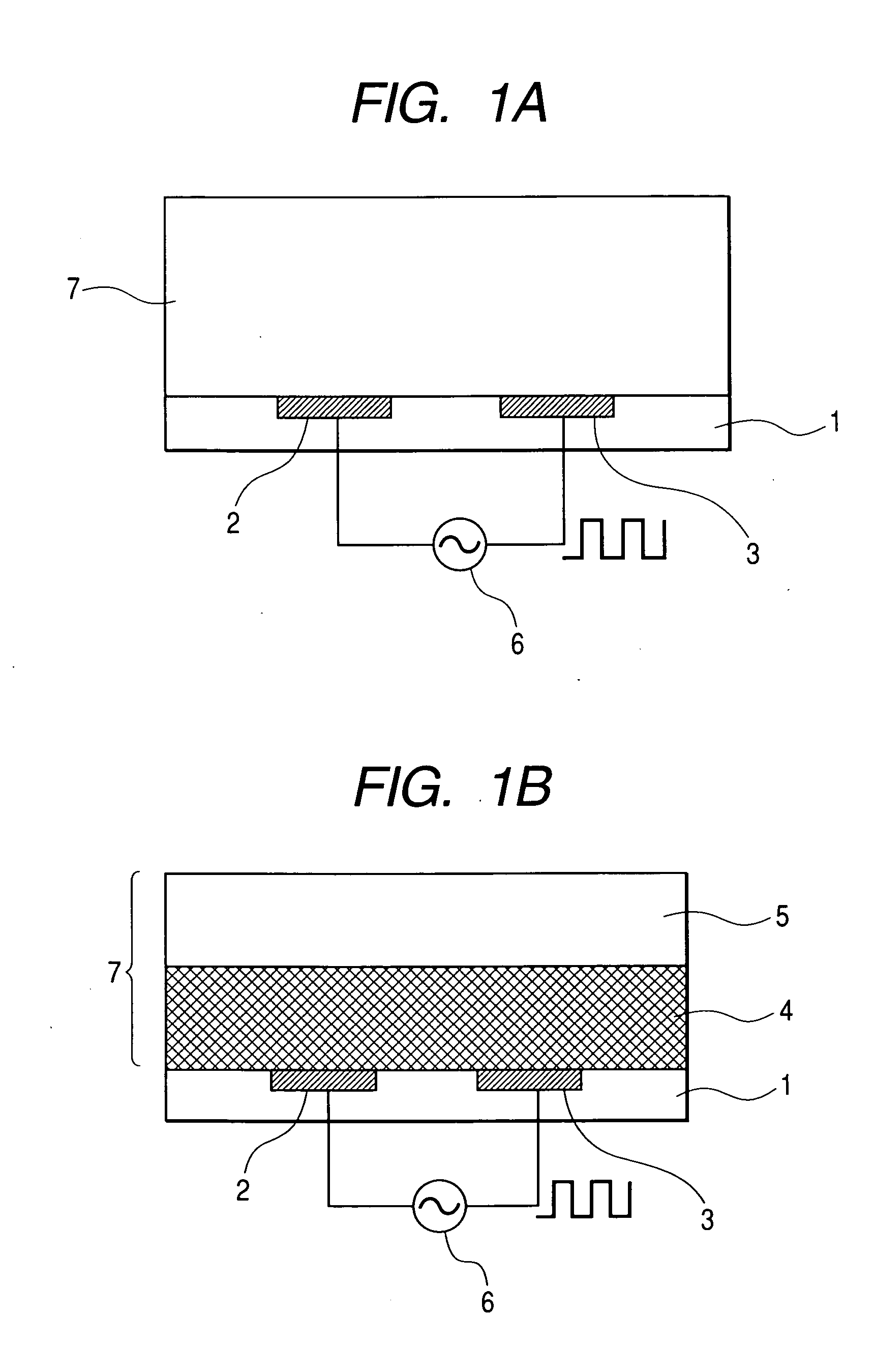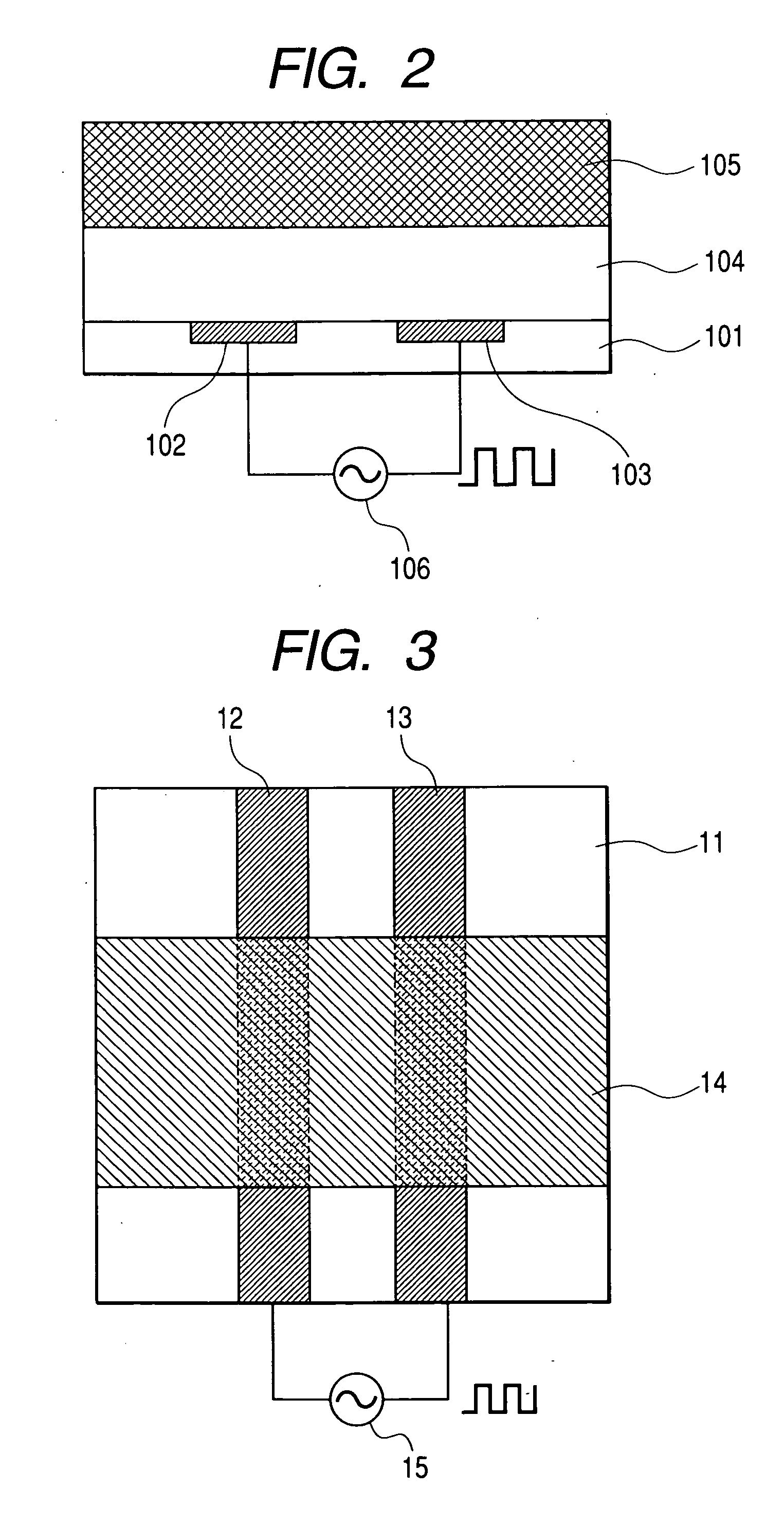Display and displaying method
a display method and information technology, applied in non-linear optics, instruments, optics, etc., can solve the problems of low electric resistance required for these layers to be used as electrodes, and the transmission of 100% has not yet been achieved for transparent electrodes, etc., to achieve bright display, no dependence on viewing angles, and high light use efficiency
- Summary
- Abstract
- Description
- Claims
- Application Information
AI Technical Summary
Benefits of technology
Problems solved by technology
Method used
Image
Examples
first exemplary embodiment
[0096] The Device and Operation
[0097] The fabrication method of an electrochromic device according to the present invention will now be explained. FIG. 14 illustrates the fabrication method of a device having the first structure using a first method. Part of a 3 cm square insulative glass substrate 361 with 1 mm thickness (FIG. 14A) is masked to form thereon two ITO electrodes 363 and 364 with a width of 5 mm and a thickness of 50 nm by magnetron sputtering (FIG. 14B). The electric resistance of the formed electrodes is 30 Ω / sq. Thereafter, an electrochromic layer 366 (FIG. 14C) with a thickness of 50 nm is formed on the substrate surface with the formed electrodes by spin coating a 5% by weight aqueous solution of a complex of poly(3,4-ethylenedioxythiophene)-polystyrenesulfonic acid for 60 sec at 4,300 rpm. A solution composed of 20% by weight of poly(ethylene oxide) with a molecular weight of 1×106, 2% by weight of lithium perchlorate, and 78% by weight of tetrahydrofuran is app...
second exemplary embodiment
The Device and Operation
[0107] In the second embodiment, materials identical to those in the first embodiment were used. The fabrication of an electrochromic device having the second structure is explained. Part of a 3 cm square insulative glass substrate with 1 mm thickness was masked to form thereon two ITO electrodes with a width of 5 mm and a thickness of 50 nm by magnetron sputtering. The electric resistance of the formed electrodes was 30 Ω / sq. Then, an electrolyte layer with 1 μm thickness was formed on the substrate surface with the formed electrodes by spin coating a solution composed of 20% by weight of poly(ethylene oxide) with a molecular weight of 1×106, 2% by weight of lithium perchlorate, and 78% by weight of tetrahydrofuran for 60 sec at 1,000 rpm. Subsequently, an electrochromic layer with 50 nm thickness was formed on the electrolyte layer by spin coating a 5% by weight aqueous solution of a complex of poly(3,4-ethylenedioxythiophene)-polystyrenesulfonic acid for...
third exemplary embodiment
[0113] An electrochromic device having the first structure of the present invention was fabricated in the same manner as that in the first embodiment except that tungsten oxide was used for the electrochromic compound and that n RF magnetron sputtering method was used to form the electrochromic layer. When a voltage was applied between the electrodes after connecting a power source to this device as in the first embodiment, reversible coloration resulted. Similarly when the device was fabricated using iridium oxide, nickel oxide, titanium dioxide, or vanadium oxide for the electrochromic compound, reversible coloration also resulted.
PUM
| Property | Measurement | Unit |
|---|---|---|
| transmittance | aaaaa | aaaaa |
| transmittance | aaaaa | aaaaa |
| thickness | aaaaa | aaaaa |
Abstract
Description
Claims
Application Information
 Login to View More
Login to View More - R&D
- Intellectual Property
- Life Sciences
- Materials
- Tech Scout
- Unparalleled Data Quality
- Higher Quality Content
- 60% Fewer Hallucinations
Browse by: Latest US Patents, China's latest patents, Technical Efficacy Thesaurus, Application Domain, Technology Topic, Popular Technical Reports.
© 2025 PatSnap. All rights reserved.Legal|Privacy policy|Modern Slavery Act Transparency Statement|Sitemap|About US| Contact US: help@patsnap.com



